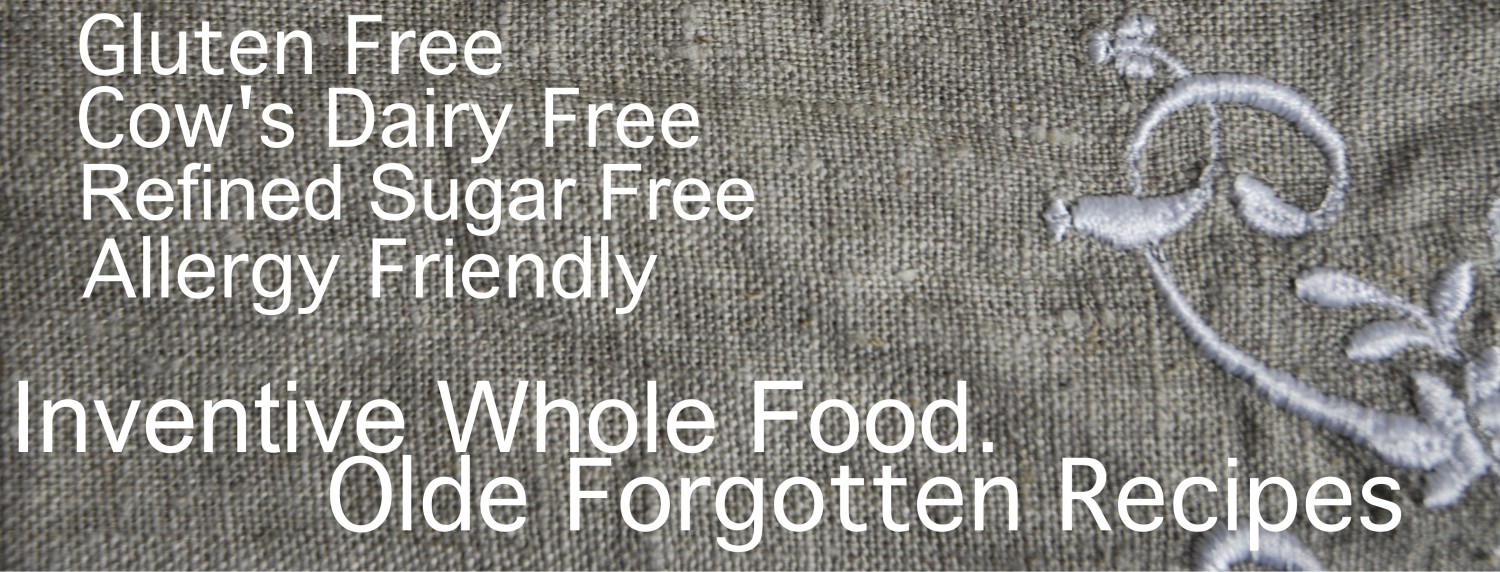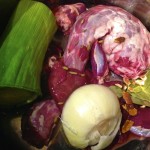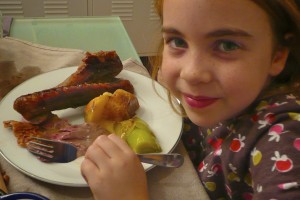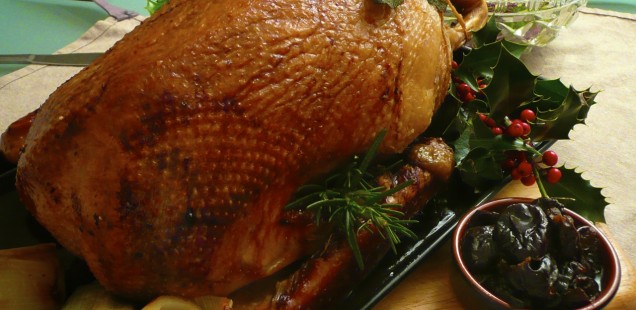
Cook: To Roast Goose in the English Fashion
The Roast Meat of Old England
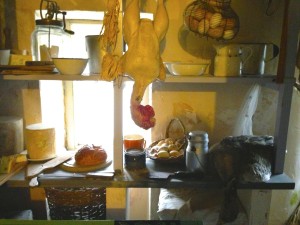 I was tempted to cook Moor Fowl, Jugged Pigeon, Ortolan or Roast Cygnet with
I was tempted to cook Moor Fowl, Jugged Pigeon, Ortolan or Roast Cygnet with 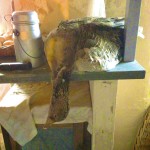 you. But of course, and probably for the best, I’m not able to source any of these birds. The Cygnet maybe – but I just couldn’t bear it.
you. But of course, and probably for the best, I’m not able to source any of these birds. The Cygnet maybe – but I just couldn’t bear it.
All the instructions in Good Things In England for the dear Young Cygnet say ‘as you do for Goose’. Goose. I can order a goose from James Elliott’s fine Butchers on Essex Rd., Islington. It is a big bird, as a friend pointed out, so, like turkey, it didn’t come cheap. £62 to be exact.
However, if you factor in what it gave us, it was a deadset bargain.
- Four large glass jars of goose fat! (that’s about £17.50 worth if you were buying at a shop)
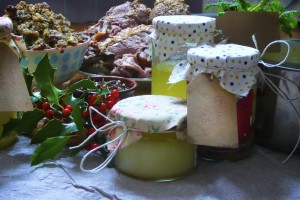
- 2 litres of rich brown organic stock
- 1 bowl piled high with quinoa & currant stuffing
- 1 overflowing platter of rich, dark, goose meat
- 1 small jug of gravy
- 1 small bowl of Armagnac Prunes
That is the leftovers after a family of four did their best to devour a goose and accoutrements for dinner.
Goose is a source of Phosphorous, zinc, protein, Vitamin A, Thiamin, Riboflavin, Niacin, Vitamin B6, Folate, Vitamin B12, Pantothenic Acid, Iron, Copper and Selenium. Excellent then for women, energy and thyroid.
The wonderful thing to know is that Goose Fat is a healthy fat. Eaten in moderation, it’s low in saturation and rich in nutrition. It’s a perfect high heat fat, so great to get a perfect crisp and oozing flavour into your roast potatoes, come Christmas time.
Why is this good to know? Because a goose is about 1/3 fat by my calculations!
I just ate a wonderful salad of wild rocket, mint, quinoa currant stuffing, roast goose and orange jelly for lunch. I didn’t make a dint in that pile of leftovers!
Roast Goose is a remarkably quick dish to get in the oven – and once there, it really looks after itself, so it’s a wonderfully easy, bountiful and tasty dinner for your Christmas table. Also a perfect Sunday Roast when you have a busy week ahead. You’ll be able to eat succulent meals all week, straight from the leftovers in the fridge.
My treasured book has pages of instructions for “Roasts”. It also insists on putting “Roast” in inverted commas at every reference. This is because, today, (“today” refers also to “back then” – this inverted commas thing is quite addictive), we are actually baking the meat, as opposed to truly roasting it.
The original “Roast” would have been a spit roast, in front of a fire, a dripping tray beneath, the meat soaking in all the “Taste of the Fire” as it cooked.
Ahh, precious flavour, lost now in the mists of technology – the taste of the fire. These words alone almost make me wish I had a big open fireplace in the kitchen instead of my oven. I did say, ‘almost’.
This is why browning the bird and deglazing all the caramelised juices from the roasting trays into the gravy remain so important in capturing the flavours of the oven.
Florence White refers often to the wisdoms of William Kitchiner, MD, 1817, whose proffered advice was compiled in conjunction with his own cook and also, Mr. Henry Osborne, cook to Sir Joseph Banks. There you are – an Australian connection for this London-based Aussie. Sir Joseph Banks is a household name in Australia because he was the botanist on the Endeavour, Captain Cook’s ship which came in 1770, claimed Australia “Terra Nullius” and planted the English flag in the sandy soils of Botany Bay.
One of the most common plants found around Botany Bay, is the Banksia.
The old men Banksia were made famous by May Gibbs with her gumnut babies stories in the 1920s.
The Banksia was named after Sir Joseph Banks, who sent beautiful hand-drawn depictions of it back to his native England.
Back in present-day London, here is an Aussie lass, lost, in her imagination, in the London of almost two hundred years ago, with said gentleman’s cook, learning how to best roast a bird.
This crack team of 19th Century cooks give their general rules for “Roasting” in the oven, which apply equally it seems to a wood fire oven, as to a gas oven in which the joint is either hung or cooked in an uncovered tin.
Use the appropriate Basting or Dredging. With a goose (and the duck), Basting is suitable. For this, we turn to details provided by Robert May (interestingly, for me at least, these are the middle names of both my children – Remy Robert and Elodie May).
“The Rarest Ways of dressing of all manner of roast meats, either flesh or fowl, by sea or land, and divers ways of breading or dredging meats to prevent the gravy from too much evaporating.” Robert May, 1665
These rare ways, spelt out by William Kitchiner MD, include Dredgings of Flour mixed with grated bread; Sweet herbs dried and powdered, and mixed with grated bread; Lemon peel fired and pounded, or orange peel mixed with flour; Sugar finely powdered, and mixed with powdered cinnamon and flour or grated bread…etc, etc.
Bastings include Fresh Butter; Clarified Suet; Minced Sweet Herbs, butter and claret, especially for mutton and lamb; Water and Salt; Cream and melted butter, especially for a flayed pig; Yolks of eggs, grated biscuit and juice of oranges.
The General Rules include facts which are wonderful for us still today – and some which are more rarely going to be of use.
Do you feel the need to pierce your bird with two hazel broaches to cook over an open fire? If you do, tie with a strong string around each end to hold it in place. A “wild fowl” will “drip its fatness from a hazel broach”. Ah, deliciously aromatic hazel gravy to be had. If you have an open fire and a hazel branch.
For the rest of us, these other suggestions may prove more useful.
1. Turn the joint or bird halfway through roasting, so that the juices may be more evenly distributed. Of course, Florence White notes,
“with the old-fashioned horizontal revolving spit this was not necessary. It was the perfect method of roasting. NB. The old roasting and cooking arrangements in the Hall of the Brewers’ Company, Addle Street, London are complete and in a good state of preservation.” Or they were at least in 1932.
These days, the local Chicken Shop will most likely have chicken on the spit, but heavily salted to conceal “meat which is inferior or insipid”. If you are going to go for your local Chicken Shop spit-roast, make sure you find a place that at least cooks Free Range chooks. Those poor barn-bred birds.
2. Joint the meat properly, preserving the fat by covering it with paper which should be tied on with fine twine (skewers let out the gravy, therefore too many should not be used).
If there is more fat than you think will be eaten with the lean (Umm, Four Jars??!!), trim it off, for it will make an excellent pudding if finely chopped; or ‘render’ (melt) it down and clarify it for frying.
3. Put some dripping in the pan, baste the bird with it well at once and throughout cooking.
This bit I love, though I didn’t do it on my goose roast:
30 minutes before the bird or joint is ready, take off the paper, sprinkle a little salt over the joint, baste it well with butter and dredge it with flour (I suggest buckwheat or chestnut); let it cook for a few minutes longer till the froth arises then dish it up. (How delicious does that sound? Like Roast Crumble!)
4. Slow Roasting is as advantageous to the tenderness and flavour of meat as slow boiling.
And just to drive home the skewer, the General Rules end with:
5. Roasting should be done by the radiant heat of a clear glowing fire; meat may be ‘roasted’ in an oven or in a pot over the fire, but in both these cases, it is in fact baked.
We get it. So here’s how to bake a goose.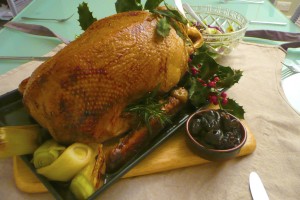
“Roast” Goose
Preparation Time: 20 mins
Cooking Time: 30 mins, then 30mins per kilo (include your stuffing in the weight)
Ingredients:
- A goose (mine, from Gressingham’s, was a 5kg bird, which is about average)
- A healthy sprig of rosemary and sage
- the juice of a lemon, Some fat and a healthy pinch of salt to rub over the skin
- 1 large potato to stand the goose a little upright.
- a handsome sprig of sage leaves to garnish when you serve (sear for 10 seconds in hot goose fat to crisp it and make it translucent)
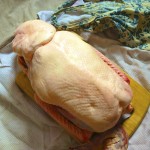
Method:
- Preheat the oven to 230°.
- Fill the bird with the stuffing below – it has two cavities, so you can choose whether you wish to stuff tail end or neck end. I stuffed tail end. Put the rosemary and sage into the end of the cavity, then tie up tightly with string to seal the hole as much as possible.
- Weigh it.
- Place your goose breast side up, on a rack, in a deep baking tray (remember all that goose fat that’s going to render?), with its tail end raised on top of the large potato.
- Rub the lemon, fat and salt all over the skin.
- My ‘tips for roasting a goose’ from Gressingham’s suggests pricking the skin, particularly around the thighs and tail to release the fat. However, our specialist chefs of old were very clear in their rules, NOT to use skewers or pierce the fat, as we want to keep it within the bird for moisture. I did not prick the bird.
- Cut off some un-needed fat from around the tail and cover the wings with it to protect them from overcooking.
- Bake for 30 minutes at 230°, then turn the oven down to 180°
- After an hour, baste with fat from the pan.
- After another hour, baste again.
- When the cooking time is finished, remove from the oven, place on a warm platter and cover with foil for 20-30mins to let the bird rest before carving.
- Use the resting time to make the good brown gravy, per the instructions below.
Carving Your Goose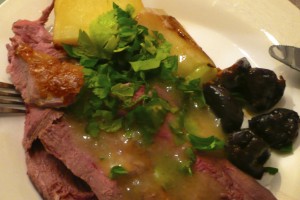
When you carve your goose, remove the drumsticks and wings first by slicing near the joints, then wiggling the joints to find where they are loose – then cut through. My kitchen scissors were frankly not up to the job! It was quite messy as a result.
Then you make slices by cutting along each breast from tail towards neck, trying to keep the knife as horizontal to the bird as possible.
The meat is dark and rich.
Stuffing – Quinoa and Currant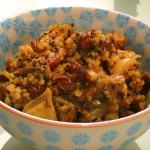
- 1 cup of quinoa (pre-cook your cup of quinoa in 1.5 cups of water or stock – I have some great tips for cooking quinoa, which I’ll be sending out soon in an email, so sign up!)
- a healthy handful of fine cut fresh parsley
- 2 tbsp of mixed herbs
- 1 goose liver, finely diced
- 1 egg, gently whisked
- 2 tbsp bread crumbs if you want a firmer bound stuffing
- the zest of a lemon
- 1 tsp ground pepper
- 1 cup currants or sultanas
Combine all the ingredients very well in a bowl. Tah dah.
Prunes in Armagnac Sauce.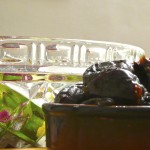
(from Cre-fydd, 1863)
I have to say, this sauce truly made the meal special – I’ll have it ready to go in a day or so, so sign up to the emails on the right and I’ll send you the link as soon as it’s ready (it will be a secret link, so join my merry band of signed-up cooks, on the right, to receive the link!) Or click here for the sign up page.
Good Brown Gravy (and Stock)
- a leek
- 3 bay leaves
- giblets and neck of the goose
- an onion cut in half
- 1 tsp fennel seeds
- half a potato
- 2 cloves of garlic
- a carrot if you have (I didn’t so I didn’t use one!)
- a stick of celery if you have (I didn’t)
- mandarin peel or the dried peel of any citrus (this is optional)
- seasoning
- Place all the ingredients in a stock pot and cover completely with water.
- Cover and bring to the boil, then reduce to a simmer for up to 2 hours.
- When ready to make your gravy, heat 1 oz of goose fat in another saucepan, with two tbsps of buckwheat flour (or any gluten free flour).
- Stir well until the mixture browns and cooks, then add about 500ml of your stock, plus any liquid gathered under the resting goose.
- Stir well until combined and thickened (less than 5 minutes).
- If you don’t have time to do this, you can simply pour 500ml of stock into a saucepan, then thicken with 1 tbsp of arrowroot or tapioca flour dissolved in 50ml of cold water. Cook, stirring, for 2 minutes before serving, to ensure that the flour has cooked.
After you’ve all eaten the meal, put all the leftover picked bones in the stock pot with the remaining stock and ingredients, cover again with water and simmer for a further 30 minutes. You should get a couple of litres of tasty goose stock from this.
Drain the stock, then place in the fridge once cool.
The next morning, remove the rendered fat from the top using a spoon. Set the fat aside with the rest of your goose fat bounty.
Place the stock in freezer containers ready to use in your upcoming soups, braises and sauces.
Sign Up for More over Email, including perfect Prune Sauce for your Goose.
My Angel’s biggest ever wing.
